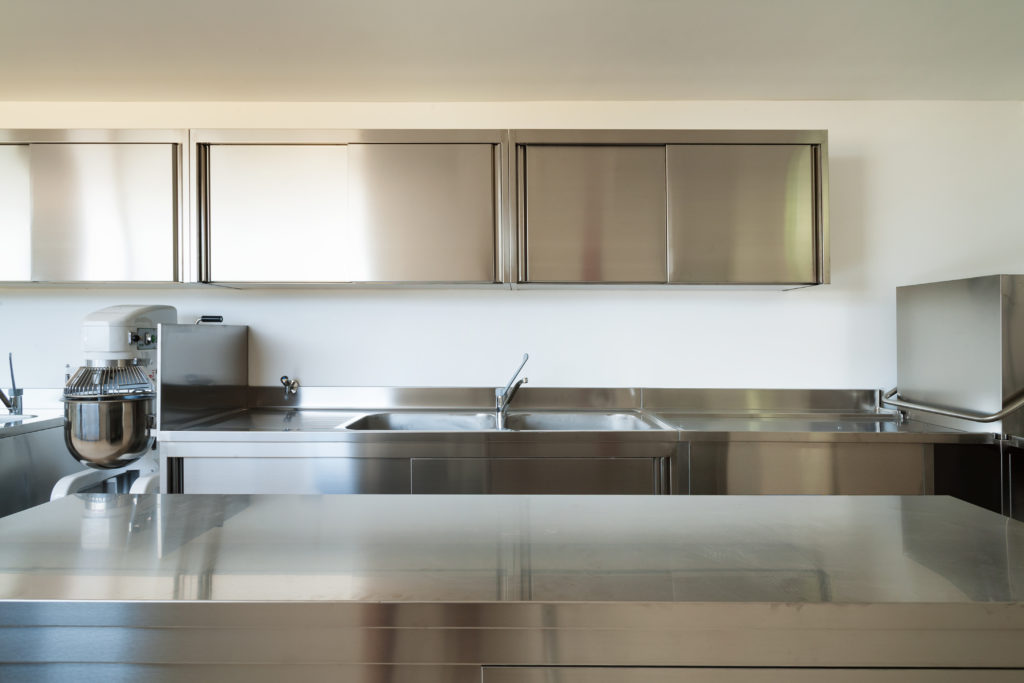
Stainless steel countertops are the obvious choice for those wanting a premium, professional-looking kitchen. After all, you can’t go wrong with what the pros use, and you’ll find stainless steel kitchen countertops in nearly every high-end restaurant from New York to Tokyo.
In fact, these countertops were once only found in the back-ends of restaurants. Now, however, they’ve made their way into mainstream kitchen design, and it’s been in large part due to the “industrial look” trend that’s taken home design by storm. Here you’ll learn if stainless is the right choice vs. other countertop options.
How Stainless Steel Countertops Are Made
Generally, one large sheet is cut down to size using a large, guillotine-like blade, and then the appropriate holes and cuts are made to account for the sink, faucets, backsplash, and turns in your counter space.
A large machine also bends the sheet in the appropriate spaces to create finished edges where necessary. Finally, any required welding is finished up at the shop before the finished products are shipped to your home.
Protective vinyl covers will protect the shine and polish during shipment, and sparse additional assembly will take place on-site to finish the installation.
All types of metal countertops are fabricated in more-or-less the same manner.
Buying prefab stainless steel countertops is also an option. These are more like tables of different sizes that can increase your overall kitchen countertop area.
Style, Design, and Installation Options
Finish
Numerous finishes and polishes are available for stainless steel. These include brushed, mirror polish, hammered, antique matte, and satin polish. A brushed finish is a favorite because it doesn’t show fingerprints as well as the others.
Many custom finishes and surface designs are available. However, the specialty designs are used primarily on backsplashes and rarely used on countertops. Most commonly countertop surfaces get a brushed or matte finish to help diminish fingerprints.
Edge Profile
Most homeowners prefer the square edge style for stainless steel countertops, but beveled, unwrapped, and bullnose (rounded) edge styles are also popular. There’s also the marine edge (much-favored by restaurants), which keeps liquids from pouring onto your shoes as you wash, slice, and prep.
Gauge
Stainless steel comes in various gauges typically ranging from 14 to 20. The lower the gauge, the thicker, stronger, quieter, and more expensive the steel. Most restaurants, for example, have 14-gauge steel.
In residential applications, using 16 or 18-gauge steel is perfectly fine. No real need for the extra expense of 14 or 12 gauge. But beware if you venture into the 20 or (heaven forbid) 22-gauge range. This is nearing quite flimsy steel that will scratch and dent almost immediately.
Seams
You shouldn’t have noticeable seams in your metal countertops. Depending on the shape of your design, it’s possible that two sheets will need to be combined — usually using a butt seam. But if this is required, all signs of the connection will be brushed out in fabrication, and you will be left with a flawlessly uniform surface and no seams.
Sinks
A hole for your sink must be cut out of your metal countertop at the fab shop. However, most homeowners opt to also have a stainless steel sink. In this case, the sink would be fit into the hole and welded to the countertop for a flawless, seamless finish.
Undercoating
Certain areas of your countertops (near the sink, for example) may benefit from pads or undercoating that can help deaden sound.
Stainless Steel Countertops: Pros & Cons
The Pros
Hygiene
Stainless steel is nonporous, which means it won’t absorb food juices, and it’s naturally antibacterial and antimicrobial. All of this means that it’s ideal for protecting you and your family from food-borne illnesses.
Resistance to Burns and Rust
Naturally non-corrosive — due in large part to the high percentage of nickel it has — stainless steel will never rust. It’s also burn-resistant, so feel free to set your piping hot pot or pan directly on the counter.
Elegant Modern Design
With its sheen and simplicity, stainless steel is both modern and timeless. It can blend with nearly any décor and always looks sleek. The reflective qualities of a stainless steel finish will also pick up on your design hues and mimic the temperature in the room. It can even help your kitchen space appear bigger than it actually is.
Drawbacks of Stainless Steel Countertops
Susceptibility to Scratching and Denting
For the most part, stainless steel is super durable and resistant to burns, rust, and breakage. But that initially perfect finish won’t last forever as scratching and denting (especially from large cookware) is eventually likely.
Damage is especially likely if you opt for a flimsy gauge. Counterintuitively, you want a lower gauge (14 or 16, ideally), which will be thicker and more resistant to scratching and denting. It will also help cut down on noise. Watch out for 20 and 22-gauge; it’s thin, loud, and more susceptible to damage.
Susceptibility to Fingerprints
You may not think that fingerprints and smudges are a big deal, but if you love a spotless kitchen, they can drive you up a wall. Take heart, however, if you still want stainless countertops.
All you need to do is opt for the brushed finish. Smudges will still happen, but the soft, smooth appearance of the finish will easily hide them.
